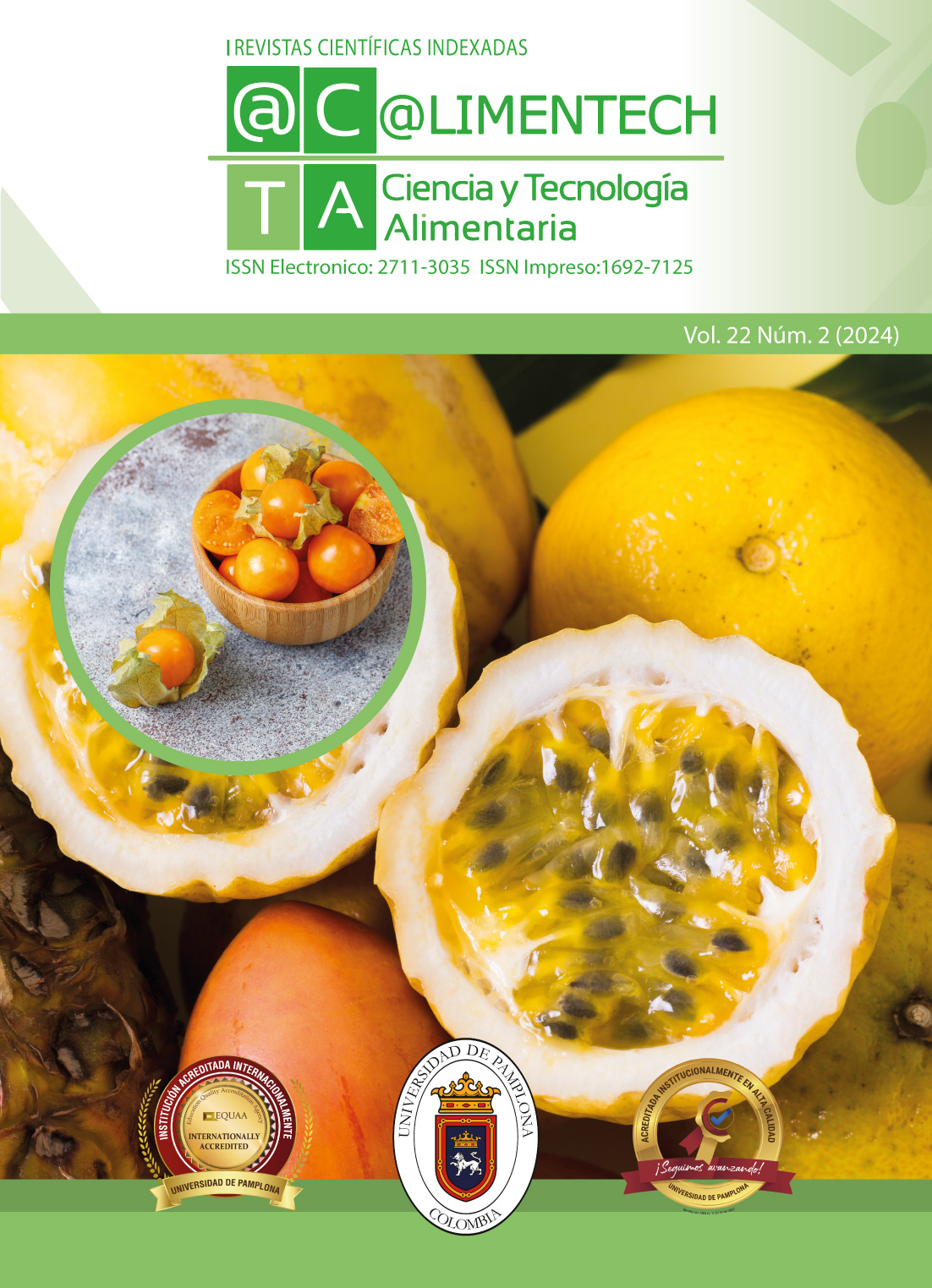Effect Of Cinnamaldehyde On The Growth Of Isolated Filament Funguses In Strawberry And Grapevine Crops
DOI:
https://doi.org/10.24054/limentech.v22i2.3654Keywords:
Filamentous fungi, Strawberry, Cape gooseberry, Cinnamaldehyde, Minimum inhibitory concentrationAbstract
The fruits of strawberry and gooseberry are highly susceptible to attack by phytopathogenic fungi due to their rich nutritional composition and high relative humidity, which favors the proliferation of these microorganisms. For this reason, these crops require the use of a large number of pesticides to reduce the impact of these pathogens.However, the use of these pesticides has caused serious health issues in humans and changes in the biodiversity of the ecosystem, making it necessary to seek natural compounds that can combat phytopathogenic fungi without harming the environment. The objective of this study was to determine the minimum inhibitory concentration (MIC) of cinnamaldehyde on the growth of filamentous fungi that cause diseases in export-quality strawberries and gooseberries. Filamentous fungi were isolated from gooseberry and strawberry samples showing signs of infection. The minimum inhibitory concentration was determined using solid and liquid PDA media mixed with different concentrations of cinnamaldehyde. Four filamentous fungi were isolated from both strawberry and gooseberry, each with distinct macroscopic characteristics. The minimum inhibitory concentration for the HBc fungus, isolated from gooseberry, was 90 µg/mL in liquid medium and 150 µg/mL in solid medium. Inhibition of the HB1 fungus, isolated from strawberries, was 450 µg/mL in solid medium and 90 µg/mL in liquid medium. The use of essential oils, such as cinnamaldehyde, is an effective alternative to reduce pesticide use and mitigate the impact on human health and the environment.
Downloads
References
Álvarez-Herrera, J. G., Fischer, G., & Vélez, J. E. (2021). Análisis de la producción de uchuva (Physalis peruviana L.) durante el ciclo de cosechas en invernadero con diferentes láminas de riego. Revista de la Academia Colombiana de ciencias exactas, físicas y naturales. https://doi.org/10.18257/raccefyn.1239. DOI: https://doi.org/10.18257/raccefyn.1239
Caballero-Pérez L. A, Tejedor-Arias R, Salas-Osorio EJ. (2023). Survival of a mixed culture of microencapsulated probiotic strains against the gastrointestinal barrier in vitro. ISSN2521-9715. Revista Científica de la Facultad de Ciencias Veterinarias – septiembre 2023. 33(2) :1-9. https://produccioncientificaluz.org/index.php/cientifica DOI: https://doi.org/10.52973/rcfcv-e33296
Cano, M. A. (2014). Estrategias biológicas para el manejo de enfermedades en el cultivo de fresa (Fragaria spp.). Revista colombiana de ciencias hortícolas, 7(2), 263-276. https://doi.org/10.17584/rcch.2013v7i2.2240 DOI: https://doi.org/10.17584/rcch.2013v7i2.2240
Canul, Y. Y. B., & Flores, I. R. I. (2019). Análisis proteómico de la pared celular del hongo Pseudocercospora fijiensis (Doctoral dissertation, Centro de Investigación Científica de Yucatán).
Díaz-Vallejo, J. J., Barraza-Villarreal, A., Yáñez-Estrada, L., & Hernández-Cadena, L. (2021). Plaguicidas en alimentos: riesgo a la salud y marco regulatorio en Veracruz, México. Salud Publica De México, 63(4), 486-497. https://doi.org/10.21149/12297 DOI: https://doi.org/10.21149/12297
Fischer, G., Almanza-Merchán, P. J., & Miranda, D. (2014). Importancia y cultivo de la uchuva (Physalis peruviana L.). Revista Brasileira De Fruticultura, 36(1), 01-15. https://doi.org/10.1590/0100-2945-441/13 DOI: https://doi.org/10.1590/0100-2945-441/13
Gómez-Suárez, Jennifer Alejandra, Méndez-Valencia, María Camila, Moncayo-Martínez, Diana Cristina, Vega-Medina, Lizeth. (2024). Desarrollo De Una Película De Ácido Poliláctico Con Un Complejo De Cinamaldehído-Betaciclodextrina Para Uchuva (Physalis Peruviana L.) Empacada. Revista @limentech, Ciencia y Tecnología Alimentaria. ISSN Impreso 1692-7125 - ISSN Electrónico 2711-3035. Volumen 22 N° 2. Pp: 65 – 77. https://doi.org/10.24054/limentech.v22i2.3617 DOI: https://doi.org/10.24054/limentech.v22i2.3617
Heidi, H. Z. M. (2023). Caracterización morfológica y genética de aislamientos de Botrytis cinerea en arándanos. https://repositorio.lamolina.edu.pe/handle/20.500.12996/5888.
Infante-Rincones Nasly Isabe; Cañate-González Abid Silvestre; Villegas-Pacheco Rosslyn Sugeys; Caselles-Algarín Campo Elías; Herrera-Demares Patricia del Carmen. (2024). Aislamiento de microorganismos patógenos en alimentos concentrados para aves de corral. Revista @limentech, Ciencia y Tecnología Alimentaria. ISSN Impreso 1692-7125 ISSN Electrónico 2711-3035. Volumen 22 N° 1. Pp: 121-138. https://doi.org/10.24054/limentech.v22i1.2867 DOI: https://doi.org/10.24054/limentech.v22i1.2867
Peñaloza Ricardo y Hernández Ordoñez. Mariela. (2018). Conservación de la uchuva (physalis peruviana l) mediante la aplicación de recubrimiento comestible a base de gel de aloe barbadensis miller. Revista @limentech, Ciencia y Tecnología Alimentaria. ISSN 1692-7125. Volumen 16 N° 2. Pp: 50 - 67. https://doi.org/10.24054/limentech.v16i2.340
Puskárová, A., Bucková, M., Kraková, L., Pangallo, D., & Kozics, K. (2017). The antibacterial and antifungal activity of six essential oils and their cyto/genotoxicity to human HEL 12469 cells. Scientific Reports, 7(1). https://doi.org/10.1038/s41598-017-08673-9 DOI: https://doi.org/10.1038/s41598-017-08673-9
Restrepo, A. M., Cortés, M., & Rojano, B. A. (2009). Determinación De La Vida Útil De Fresa (Fragaria Ananassa Duch.) Fortificada Con Vitamina E. Dyna, 76(159), 163-175. https://dialnet.unirioja.es/descarga/articulo/7603117.pdf.
Sánchez, F. (2019). La resistencia de las plagas y enfermedades ante el control convencional y la búsqueda de alternativas de biocontrol. Tierra Infinita (Universidad Politécnica Estatal del Carchi - Impresa), 5(1), 234-243. https://doi.org/10.32645/26028131.975. DOI: https://doi.org/10.32645/26028131.975
Sempere-Ferre, F., Asamar, J., Castell, V., Roselló, J., & Santamarina, M. P. (2021). Evaluating the antifungal potential of botanical compounds to control Botryotinia fuckeliana and Rhizoctonia solani. Molecules, 26(9), 2472. https://doi.org/10.3390/molecules26092472 DOI: https://doi.org/10.3390/molecules26092472
Tancinová, D., Masková, Z., Mendelová, A., Foltinová, D., Barboráková, Z., & Medo, J. (2022). Antifungal activities of essential oils in vapor phase against botrytis cinerea and their potential to control postharvest strawberry gray mold. Foods, 11(19), 2945. https://doi.org/10.3390/foods11192945 DOI: https://doi.org/10.3390/foods11192945
Vega, J. S., Ruiz Cifuentes, & Vásquez Ardila. (2017). Plan de negocios para la producción y exportación de fresa orgánica.
Universidad La Salle. https://hdl.handle.net/20.500.14625/30932.
Wang, D., Zhang, J., Jia, X., Li, X., & Zhai, H. (2019). Antifungal effects and potential mechanism of essential oils on collelotrichum gloeosporioides in vitro and in vivo. Molecules, 24(18), 3386. https://doi.org/10.3390/molecules24183386. DOI: https://doi.org/10.3390/molecules24183386
Downloads
Published
How to Cite
Issue
Section
License
Copyright (c) 2024 @limentech, Ciencia y Tecnología Alimentaria

This work is licensed under a Creative Commons Attribution-NonCommercial 4.0 International License.








